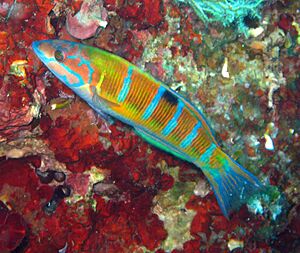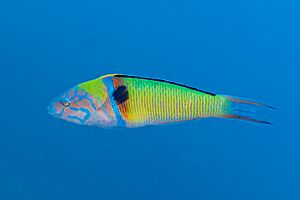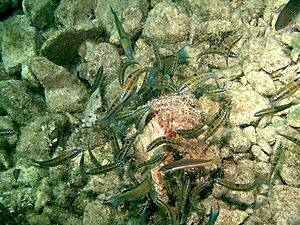Ornate wrasse facts for kids
Quick facts for kids Ornate wrasse |
|
|---|---|
 |
|
| female | |
 |
|
| male | |
| Conservation status | |
| Scientific classification | |
| Synonyms | |
|
The ornate wrasse (Thalassoma pavo) is a colorful fish that lives in the ocean. It is a type of wrasse fish. You can find it near rocky coasts in the eastern Atlantic Ocean and the Mediterranean Sea. This fish is sometimes caught by local fishermen. It is also a popular game fish for sport fishing. You might even see it in an aquarium!
Contents
About the Ornate Wrasse: What It Looks Like
The ornate wrasse is special because males and females look different. This is called sexual dichromatism.
Colors and Patterns of Males and Females
- Female ornate wrasse are usually greenish-brown. They have a dark bar on each scale. They also have five bluish stripes that go up and down their bodies.
- Male ornate wrasse have red heads with blue markings. Behind their front fins, they have a blue stripe with red edges.
- Both males and females have a turquoise tail fin.
- Young ornate wrasse are green all over. They have a black spot in the middle of their back, right under their top fin.
Body Shape and Size
The ornate wrasse has a long, flat body. Its head is sharp and oval-shaped. It has a short snout and a small mouth with thick lips.
Younger fish have a straight tail fin. As they get older, their tail fin becomes curved inward. The outer parts of the tail can even grow into long, thin strands. This fish can grow up to 25 centimeters (about 10 inches) long. However, most are usually around 20 centimeters (about 8 inches).
Where the Ornate Wrasse Lives
The ornate wrasse lives in the eastern Atlantic Ocean and the Mediterranean Sea.
Atlantic Ocean Homes
In the eastern Atlantic, you can find them from Portugal down to Senegal in West Africa. They also live around several island groups. These include the Cape Verde Islands, Canary Islands, Madeira, Salvage Islands, and the Azores.
Mediterranean Sea Homes
In the Mediterranean Sea, they live along most of the African and Asian coasts. They are also found along most northern coasts. However, they are not common in the northern Adriatic Sea or some parts of the northwestern Mediterranean.
Scientists think that global warming might be helping the ornate wrasse spread further north. They are now seen more often in places like the Ligurian Sea and off Provence. This fish does not live in the Black Sea.
Home and Habits: What the Ornate Wrasse Does
The ornate wrasse likes to live in rocky areas. It also enjoys places with lots of algae and Posidonia sea grass beds. You can find them from the surface down to about 50 meters (164 feet) deep. They can even live around human-made structures like shipwrecks, piers, and jetties.
Social Life
Female wrasse and young fish usually live in small groups. Adult males, however, prefer to live alone. During the breeding season, males become territorial. They will guard a group of females, called a harem.
What They Eat
The ornate wrasse eats small molluscs and crustaceans. Young wrasse sometimes act as cleaner fish. This means they eat tiny ectoparasites (small creatures that live on the outside of other fish) from the skin of other fish. When hunting for food, they swim with quick, jerky movements.
Sleeping Habits
At night, these fish bury themselves in sandy areas. They shake their tails strongly to dig into the sand. They then spend the night lying on their sides, hidden in the sand.
Reproduction and Life Cycle
The ornate wrasse is a protogynous hermaphrodite. This is a fancy way of saying that females can change into males! When a female changes into a male, its colors also change.
Because females can change gender, there are many young, fertile females in the population. This means they can produce many eggs. There are fewer older, larger males because they face more dangers from predators. The fish lay their eggs in the spring. These eggs float freely in the water.
Ornate Wrasse and People
People use the ornate wrasse in a few ways.
Fishing
Local fishermen in the eastern Mediterranean and around the Macaronesian islands catch the ornate wrasse. They use both fishing hooks and lines, as well as traps.
Aquarium Trade
You can also find the ornate wrasse in the aquarium trade. People sometimes keep them as pets in home aquariums.
Naming the Ornate Wrasse
The ornate wrasse was first officially described in 1758. It was named Labrus pavo by a famous scientist named Carolus Linnaeus. He wrote about it in his book Systema Naturae. He said it was found in Syria.



